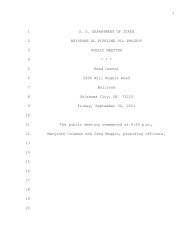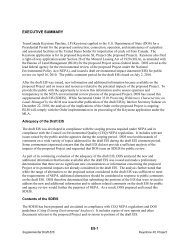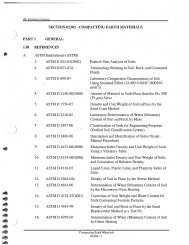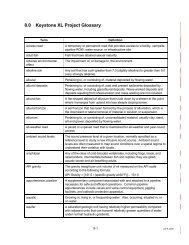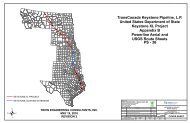2.1 Overview of the Proposed Project - Keystone XL pipeline - US ...
2.1 Overview of the Proposed Project - Keystone XL pipeline - US ...
2.1 Overview of the Proposed Project - Keystone XL pipeline - US ...
You also want an ePaper? Increase the reach of your titles
YUMPU automatically turns print PDFs into web optimized ePapers that Google loves.
Draft Supplemental Environmental Impact Statement<strong>Keystone</strong> <strong>XL</strong> <strong>Project</strong>In addition to <strong>the</strong> proposed <strong>pipeline</strong> crossings <strong>of</strong> waterbodies, <strong>the</strong>re would be temporaryequipment bridges installed across many waterways. The actual crossing method employedwould depend on any permit conditions from <strong>US</strong>ACE and o<strong>the</strong>r relevant regulatory agencies.Prior to <strong>the</strong> start <strong>of</strong> clearing along each <strong>pipeline</strong> construction spread, temporary bridges (e.g.,subsoil fill over culverts, timber mats supported by flumes, railcar flatbeds, or flexi-floatapparatus) would be installed across all perennial waterbodies to allow construction equipment tocross with reduced disturbance. Clearing crews would be allowed only one pass through <strong>the</strong>waterbodies prior to temporary bridge construction. All o<strong>the</strong>r construction equipment would berequired to use <strong>the</strong> bridges. Waterbodies would be crossed using one <strong>of</strong> four different open-cutmethods or <strong>the</strong> HDD method. These waterbody crossing methods are described below.<strong>2.1</strong>.9.1 Open-Cut Crossing MethodsFor most waterbodies to be crossed by <strong>the</strong> proposed <strong>Project</strong>, one <strong>of</strong> <strong>the</strong> open-cut methods listedbelow would be used:• Non-flowing open-cut crossing method (for waterbodies that do not have a perceptible flowat <strong>the</strong> time <strong>of</strong> construction);• Flowing open-cut crossing method;• Dry-flume open-cut method; or• Dry dam-and-pump open-cut method.The trenching, <strong>pipeline</strong> installation, and backfilling methods used for <strong>the</strong>se types <strong>of</strong> crossingswould be similar to <strong>the</strong> crossing methods described above.Non-Flowing Open-Cut Crossing MethodThe non-flowing open-cut method would be used for all waterbodies with no visible flow at <strong>the</strong>time <strong>of</strong> construction. In <strong>the</strong> event that intermittent waterbodies are dry or have non-moving waterat <strong>the</strong> time <strong>of</strong> crossing, <strong>Keystone</strong> would install <strong>the</strong> <strong>pipeline</strong> using this method. Detail 11 <strong>of</strong> <strong>the</strong>CMRP (Appendix G) is an illustration <strong>of</strong> a typical open-cut crossing method for non-flowingwaterbodies.Flowing Open-Cut Crossing MethodIf <strong>the</strong>re is flow at <strong>the</strong> time <strong>of</strong> construction, <strong>the</strong> flowing open-cut method would be used and <strong>the</strong>trench would be excavated through flowing water. If an intermittent waterbody is flowing whencrossed, <strong>Keystone</strong> would install <strong>the</strong> <strong>pipeline</strong> using this method. Backhoes operating from one orboth banks would excavate <strong>the</strong> trench within <strong>the</strong> streambed while water continues to flowthrough <strong>the</strong> construction work area (see Detail 12 <strong>of</strong> Appendix G, CMRP). In wider rivers, instreamoperation <strong>of</strong> equipment may be necessary. <strong>Keystone</strong> would trench through <strong>the</strong> channel,lower in a pipe that is weighted for negative buoyancy, <strong>the</strong>n backfill. The need for negativebuoyancy would be determined by detailed design and site-specific considerations at <strong>the</strong> time <strong>of</strong>construction. Material excavated from <strong>the</strong> trench generally would be placed at least 10 feet awayfrom <strong>the</strong> water’s edge unless stream width exceeds <strong>the</strong> reach <strong>of</strong> <strong>the</strong> excavation equipment.Sediment barriers would be installed where necessary to prevent excavated spoil from entering<strong>the</strong> water. Hard or s<strong>of</strong>t trench plugs would be placed to prevent <strong>the</strong> flow <strong>of</strong> water into <strong>the</strong> uplandportions <strong>of</strong> <strong>the</strong> trench. After installation, <strong>the</strong> grade would be restored to pre-construction<strong>Project</strong> Description <strong>2.1</strong>-56 March 2013



